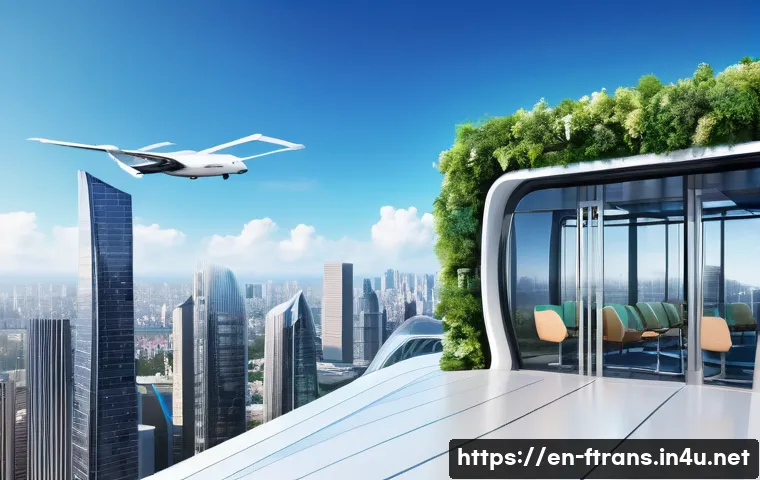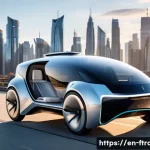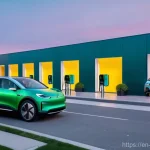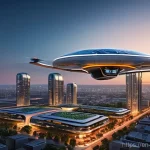The idea of flying cars has been around for decades, capturing our imaginations with visions of effortlessly soaring above traffic jams. In 2025, this once far-fetched concept is rapidly approaching reality.

Companies are actively developing different types of flying cars, from vehicles that resemble mini-helicopters to those that maintain a more traditional car-like appearance.
These innovations aim to revolutionize urban mobility, offering a way to bypass congested roads and shorten travel times. Several models are expected to be available soon, each with unique features and capabilities.
Some flying cars offer vertical takeoff and landing (VTOL) capabilities, making them suitable for urban environments, while others require runways. Electric propulsion is becoming increasingly popular, offering eco-friendly and quiet operation, although hybrid systems are also being explored to extend the range.
Let’s delve into the exciting world of flying cars and explore the various types that are poised to reshape how we travel!
## The Sky’s the Limit: How Flying Cars Are Shaping Tomorrow’s CommuteImagine a world where traffic jams are relics of the past, and your daily commute involves a smooth, scenic flight above the city.
This isn’t a scene from a science fiction movie; it’s a glimpse into the near future, thanks to the rapid development of flying cars. Forget the Jetsons – these vehicles are becoming a tangible reality, poised to transform how we navigate our increasingly congested urban landscapes.
As someone who’s always looking for the next big thing in transportation, I’ve been closely following the advancements in this field, and I’m excited to share some insights into the different types of flying cars and their potential impact.
The Rise of VTOL: Vertical Takeoff and Landing Vehicles
One of the most promising designs for flying cars is the Vertical Takeoff and Landing (VTOL) vehicle. These aircraft don’t require a runway, making them perfect for navigating densely populated urban areas.
I remember being stuck in rush-hour traffic last week, and the thought of simply lifting off and flying over the gridlock was incredibly appealing. VTOLs achieve this capability through various propulsion methods, including:* Multi-copter Designs: These resemble oversized drones, using multiple rotors to generate lift and control movement.
They are relatively simple in design but can be limited in terms of range and speed. * Tilt-rotor Systems: These designs combine the vertical lift of helicopters with the efficient forward flight of airplanes.
The rotors can tilt to provide vertical lift for takeoff and landing and then rotate forward for horizontal flight. * Ducted Fan Technology: This involves enclosing the rotors within ducts, which can improve efficiency and reduce noise.
It’s like having a super-powered fan that propels you through the air. I’ve seen some impressive prototypes of VTOL flying cars, and the technology is advancing rapidly.
The potential for these vehicles to revolutionize urban transportation is immense, offering a way to bypass congested roads and significantly reduce travel times.
The Electric Revolution: Sustainable Skies
As the world becomes increasingly conscious of environmental impact, electric propulsion is taking center stage in the development of flying cars. Electric Vertical Takeoff and Landing (eVTOL) vehicles offer a sustainable alternative to traditional combustion engine aircraft.
The benefits of electric propulsion are numerous:* Zero Emissions: eVTOLs produce no tailpipe emissions, contributing to cleaner air in urban areas.
Imagine a city where the air is fresh and clean, even with flying cars zipping around. * Quieter Operation: Electric motors are significantly quieter than combustion engines, reducing noise pollution.
* Reduced Operating Costs: Electricity is generally cheaper than fuel, leading to lower operating costs for eVTOLs. Several companies are investing heavily in eVTOL technology, and I believe it will play a crucial role in the future of urban air mobility.
The challenge lies in improving battery technology to increase the range and payload capacity of these vehicles.
The Roadable Aircraft: A Hybrid Approach
For those who prefer the familiarity of a car, roadable aircraft offer a unique blend of driving and flying capabilities. These vehicles can transition between driving on roads and flying in the air, providing unparalleled flexibility.
The concept is pretty straightforward: a car with wings that can be deployed for flight. Some designs even allow the wings to be folded away for driving, making them street-legal.
Roadable aircraft offer several advantages:* Versatility: They can be driven on roads, eliminating the need for separate ground transportation. * Convenience: They can take off and land from airports or designated landing strips, providing access to a wider range of destinations.
* Flexibility: They can adapt to changing traffic conditions, allowing drivers to bypass congestion by taking to the air. I’ve always been fascinated by the idea of a car that can fly, and roadable aircraft bring that dream closer to reality.
However, these vehicles also face challenges, including regulatory hurdles and the need for pilots licenses.
Safety First: Ensuring Safe Skies for All
Safety is paramount in the development of flying cars, and manufacturers are implementing rigorous testing and safety measures to ensure the safety of passengers and the public.
This includes:* Redundant Systems: Flying cars are equipped with multiple backup systems to ensure that they can safely land in the event of a failure.
* Advanced Sensors: They use advanced sensors and navigation systems to avoid obstacles and navigate safely through the airspace. * Automated Flight Controls: Many flying cars feature automated flight controls, which can assist pilots in maintaining stable flight and avoiding collisions.
Regulatory agencies like the Federal Aviation Administration (FAA) are also working to develop safety standards and regulations for flying cars. It’s a collaborative effort between manufacturers, regulators, and industry experts to ensure that flying cars are safe and reliable.
Navigating the Rules of the Air: Regulations and Infrastructure
The widespread adoption of flying cars will require a robust regulatory framework and infrastructure to manage the airspace and ensure safety. This includes:* Air Traffic Management Systems: New air traffic management systems will be needed to track and manage the movement of flying cars in urban airspace.
* Designated Air Corridors: Designated air corridors may be established to guide flying cars along predefined routes. * Vertiports: Vertiports, or landing pads for VTOL aircraft, will need to be built in urban areas to provide takeoff and landing facilities.
The development of these regulations and infrastructure is a complex process, but it is essential for the safe and efficient integration of flying cars into our transportation system.
The Cost of Flight: Affordability and Accessibility

One of the biggest challenges facing the flying car industry is affordability. Currently, flying cars are expected to be quite expensive, potentially limiting their accessibility to a select few.
However, as technology advances and production scales up, the cost of flying cars is expected to decrease, making them more affordable for the general public.
There are ways to make flying cars more accessible such as:* Sharing Economy Models: Shared ownership or rental programs could make flying cars more affordable for individuals who don’t want to own one outright.
* Public Transportation: Flying cars could be integrated into public transportation systems, providing a convenient and affordable way to travel within cities.
* Government Subsidies: Government subsidies or tax incentives could help to lower the cost of flying cars, making them more accessible to a wider range of people.
I believe that flying cars have the potential to transform transportation, but it’s important to ensure that they are accessible to everyone, not just the wealthy elite.
The Future is Now: Embracing the Skies
Flying cars are no longer a futuristic fantasy; they are a rapidly approaching reality. With advancements in technology, increasing investment, and growing public interest, the dream of soaring above traffic jams is closer than ever before.
As someone who has been following this industry closely, I am excited to see how flying cars will shape the future of transportation and urban mobility.
I fully believe they will change our lives forever.
| Flying Car Type | Propulsion Method | Advantages | Disadvantages |
|---|---|---|---|
| VTOL (Vertical Takeoff and Landing) | Multi-copter, Tilt-rotor, Ducted Fan | No runway required, suitable for urban areas | Limited range and speed (multi-copter), complex design (tilt-rotor) |
| eVTOL (Electric Vertical Takeoff and Landing) | Electric Motors | Zero emissions, quieter operation, reduced operating costs | Limited battery range, lower payload capacity |
| Roadable Aircraft | Combustion Engine or Hybrid | Versatile, convenient, flexible | Regulatory hurdles, need for pilot’s license |
The future of commuting is looking up, quite literally! With various designs and technologies in play, flying cars promise to reshape our cities and daily lives.
Wrapping Up
As we’ve explored, the development of flying cars is not just a futuristic fantasy but a rapidly evolving reality. From VTOL designs to electric propulsion and roadable aircraft, the innovations are transforming urban mobility. While challenges like safety, regulations, and affordability remain, the progress made so far is genuinely exciting. Imagine a future where traffic jams are a distant memory, and the sky is the limit for your daily commute. As technology continues to advance and regulations adapt, flying cars could soon become an integral part of our transportation landscape. The journey to the skies is underway, and I can’t wait to see where it takes us.
Good to Know
Here are some quick facts about flying cars:
1. VTOL Versatility: Vertical Takeoff and Landing (VTOL) aircraft don’t need runways, making them perfect for urban environments. This means you could potentially take off from a designated spot near your home or office.
2. Electric Power: Electric Vertical Takeoff and Landing (eVTOL) vehicles offer a sustainable, emission-free alternative to traditional aircraft. This helps reduce air pollution and makes our cities cleaner.
3. Roadable Flexibility: Roadable aircraft combine driving and flying capabilities, offering unparalleled flexibility. You can drive to an airport, take off, and then drive again at your destination.
4. Safety First: Flying cars come with redundant systems, advanced sensors, and automated flight controls to ensure passenger safety. These features help prevent accidents and ensure a safe journey.
5. Regulatory Progress: Regulatory agencies like the FAA are developing safety standards and regulations for flying cars. These regulations are essential for the safe integration of flying cars into our transportation system.
Key Takeaways
Flying cars are poised to revolutionize transportation, offering a way to bypass traffic congestion and reduce travel times. While challenges remain, the advancements in technology and increasing investment make the dream of flying cars closer than ever. Here are some points to remember:
Diverse Designs: VTOLs, eVTOLs, and roadable aircraft each offer unique advantages and cater to different needs. VTOLs excel in urban environments, eVTOLs offer sustainability, and roadable aircraft provide versatility.
Sustainability Matters: Electric propulsion is a key factor in making flying cars environmentally friendly. eVTOLs produce zero emissions and operate more quietly than traditional aircraft.
Infrastructure Needs: The widespread adoption of flying cars will require new air traffic management systems, designated air corridors, and vertiports. These infrastructure developments are essential for the safe and efficient operation of flying cars.
Affordability is Key: Making flying cars accessible to the general public is a critical challenge. Sharing economy models, public transportation integration, and government subsidies can help lower costs and make flying cars more affordable.
Safety is Paramount: Rigorous testing, redundant systems, and regulatory oversight are essential to ensure the safety of flying cars. These measures will help build public trust and ensure the safe integration of flying cars into our transportation system.
Frequently Asked Questions (FAQ) 📖
Q: When can I actually buy one of these amazing flying cars and start soaring above traffic?
A: Oh, believe me, that’s the dream question everyone’s asking, and I’ve been following the progress super closely! While some companies are indeed showcasing incredible prototypes and even opening up pre-orders for initial models, the widespread availability for personal ownership, like you might buy a car today, is still a few years out.
From what I’m seeing and hearing from industry insiders, we’re likely to see commercial air taxi services launching in select, forward-thinking cities by the late 2020s.
Think of it as a phased rollout, starting with more controlled environments and professional operators. The big hurdle isn’t just the tech, which is truly mind-blowing, but also the regulations – ensuring these vehicles are incredibly safe and integrating them into existing airspace.
But honestly, the momentum is incredible. My personal take is that by 2030, we’ll start seeing a genuine shift, and I wouldn’t be surprised if some pioneering individuals in urban hubs are already ditching their road commutes for a quick flight by then.
It’s no longer a sci-fi fantasy; it’s a very real future being built right before our eyes!
Q: How safe are these flying cars going to be, especially if they’re zipping around over our heads?
A: Safety, safety, safety! It’s absolutely the number one concern, and rightfully so. When I first started diving into this topic, that was my immediate thought too.
The good news is, the industry and regulatory bodies are taking an incredibly rigorous approach to this. We’re not talking about car-level safety standards; we’re talking aviation-level, which are the most stringent in the world!
Manufacturers are building these vehicles with multiple redundant systems, meaning if one part fails, there’s a backup (or even a backup to the backup!) to ensure continuous safe operation.
They’re also incorporating advanced autonomous flight systems and AI to assist pilots or even fly the vehicle entirely. Think of the sheer amount of testing, simulating, and real-world trials these flying cars are undergoing – it’s phenomenal.
My personal observation is that they understand public trust hinges entirely on an impeccable safety record, so they are going above and beyond to make these as safe, if not safer, than anything we’ve ever flown before.
Seriously, the dedication to safety is inspiring.
Q: Will I need a full-blown pilot’s license to fly one of these, or will it be more like driving a car?
A: This is a brilliant question because it directly impacts how many of us can actually experience this revolution! For the initial wave of personal flying vehicles, especially those that aren’t fully autonomous, it’s very likely you’ll need some specialized training, probably leading to a new type of pilot certification specifically designed for these eVTOL (electric Vertical Take-Off and Landing) aircraft.
It won’t be as extensive as getting a commercial airline pilot’s license, but it will definitely be more involved than just passing a driving test. However, and this is where it gets really exciting, the ultimate goal for mass adoption is to make flying as easy, if not easier, than driving.
Many companies are heavily investing in highly intuitive controls, and advanced autonomous systems that will do most, if not all, of the flying for you.
Imagine simply inputting your destination and letting the vehicle handle the rest, much like a super advanced self-driving car. So, while early adopters might need to brush up on some flight skills, I truly believe that within the next decade, operating a flying car will become incredibly simplified, making sky-high commutes accessible to a much broader audience.
I’m personally rooting for the “press a button and go” future!






